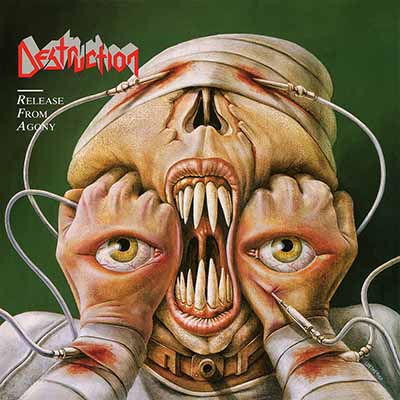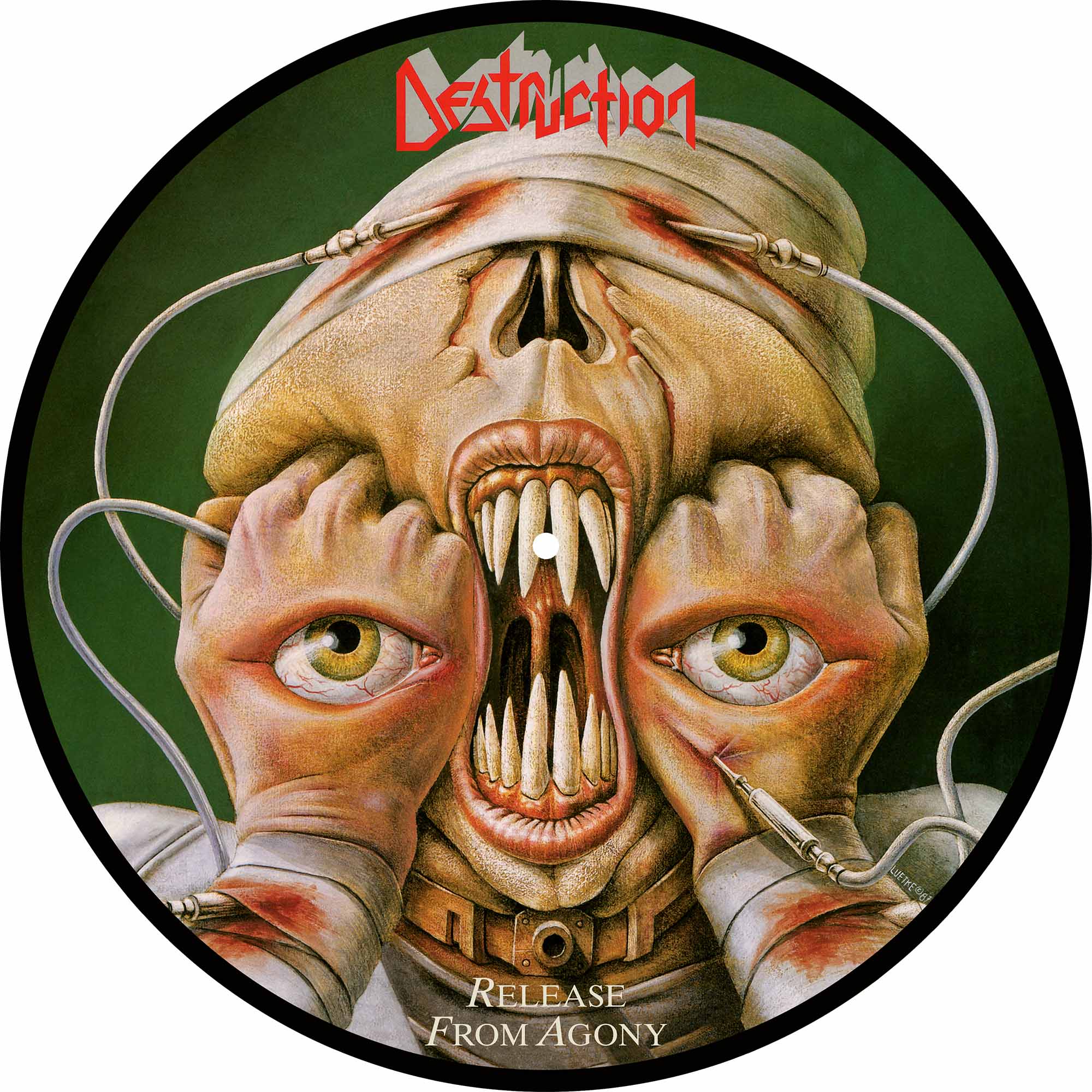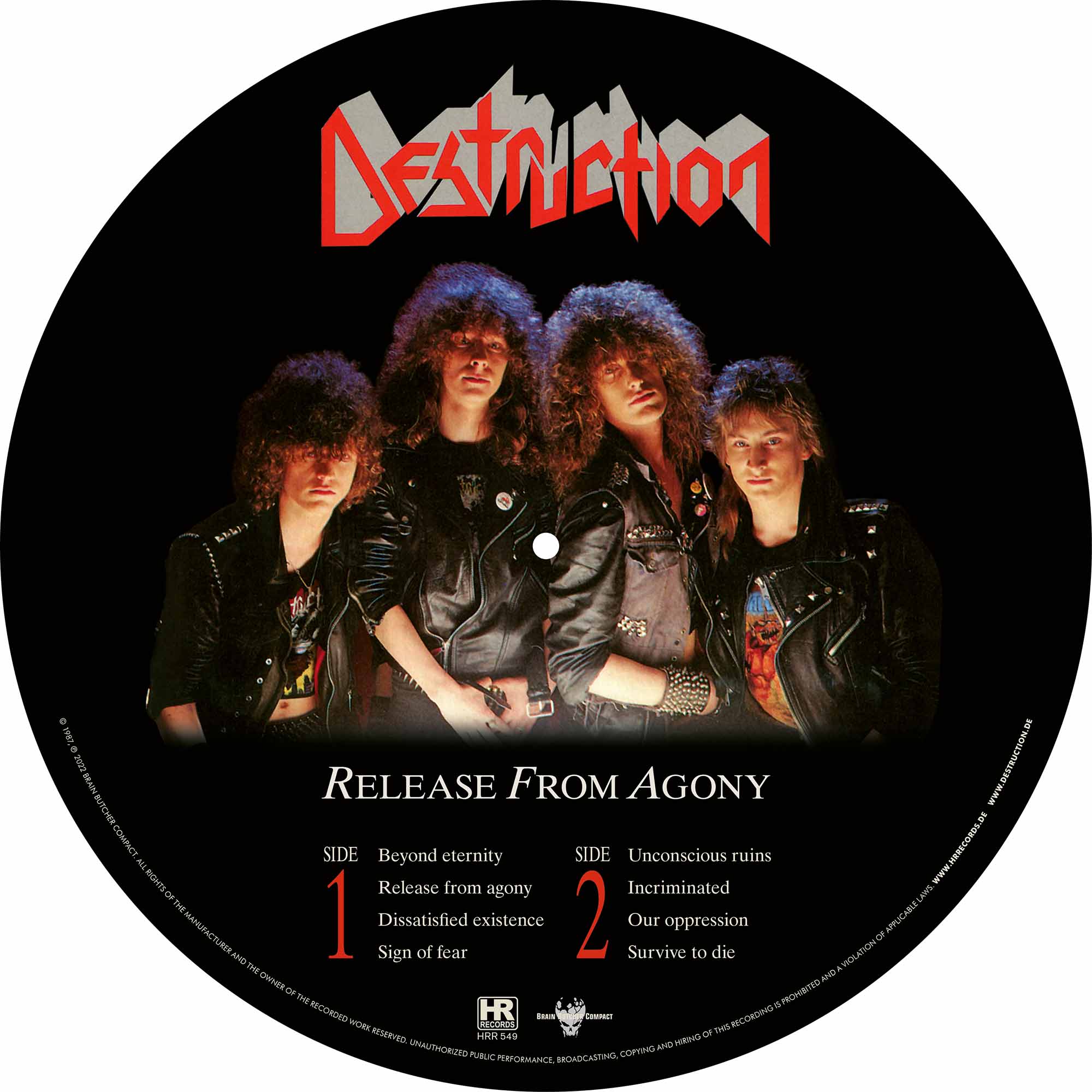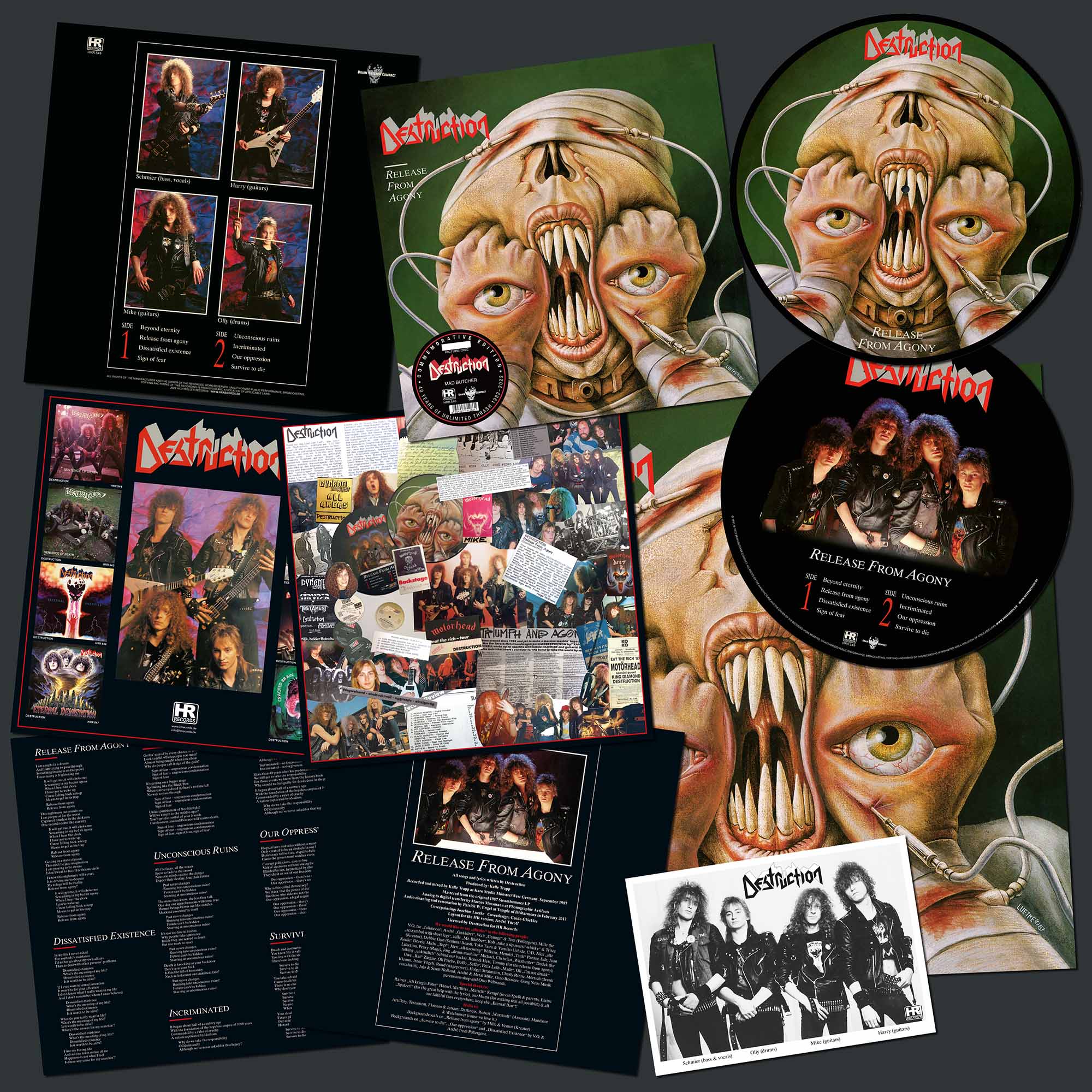 | ||||
| DESTRUCTION - Release from Agony PICTURE LP | |
HRR 549PLP, Commemorative Edition, 40 Years of unlimited Thrash, ltd 550, individually numbered, 425gsm heavy cardboard cover, printed inner sleeve, insert, poster, A5 photo | |
| Schmier - Bass, Vocals Mike Sifringer - Guitars Harry Wilkens - Guitars Oliver Kaiser - Drums | |
| 1. Beyond Eternity 2. Release from Agony 3. Dissatisfied Existence 4. Sign of Fear 5. Unconscious Ruins 6. Incriminated 7. Our Oppression 8. Survive to Die | |
AVAILABLE | |
Mastered by Patrick W. Engel at TEMPLE OF DISHARMONY in February 2017.
When first released in 1987 via Steamhammer, Destruction's third full-length album “Release from Agony” scored a 9 out of 10 in the German Rock Hard Magazine, where it was even called “the best Destruction-LP of all”. And yes, many people would agree that this album is the most ambitious and most controversial of the first studio albums, with a more technical and much darker approach. It went further down a path that Destruction had paved with “Mad Butcher”.
“I think this album was ahead of its time,” muses Schmier. “Maybe we wanted to achieve a touch too much but we were young and we were aiming for progress. The only thing I don’t like about the record is its production, which is too compressed and thin. Did we succeed? I guess all the Death Metal bands in the 90s that named this album as an influence are a good prove for that. Fuck yeah!” What bands come to his mind when he says that? “Let’s say, the American Death Metal scene, especially Florida loved that record… at least that’s what they all told me…haha!”
There is a story floating around that while recording “Release from Agony” sound-wise everything had been fine until the rough mix was finished, and after that producer Kalle Trapp made a botch of the whole sound. Is that correct? Oli confirms this rather sad tale: “Yes, yes, tragically yes. We kept asking for the real test pressings, because what we got to hear sounded like a bad joke. It had nothing to do with the rough-mix we had done in the studio. New test pressings kept coming but to no avail. Instead of going to the studio to some kick ass, Steamhammer opted to release the agony. A few weeks after the release, the producer called up saying he finally found out that he pushed all the wrong buttons when mixing it, he had all the mufflers on. Very unfortunately the tapes have disappeared and we’ll never have a chance to let everybody listen to 'Release from Agony' the way it was meant to be released. Nevertheless, we are very happy to have it restored by HR Records – with an ear to history, so to speak…”
All the sound issues aside, “Release from Agony” is technically brilliant, it’s a two-fisted thrash missile, displaying an extraordinary level of musicianship; on top of that, it contains guest vocals by Mille and Ventor of Kreator and V.O. Pulver and André Grieder from Poltergeist. Was “Release from Agony” Destruction's (conscious) contribution to a movement within thrash metal that went for a more complex and refined (not to say progressive) kind of playing thrash? Mike responds to this question: “At that time, I was very much into bands like Watchtower and Fates Warning but also Rush and Yes. I found the strange harmonies and all the odd beats very charming and interesting and still do. So I decided to bring some of those ideas into Destruction. Schmier was not very amused about it.”
Seems as if he was not the only one. Some people find “Release from Agony” less unrestrained than the former albums, maybe a bit “too” mature and not as easily accessible as the first two albums. What’s the band's opinion on this? Do they maybe regret to have put so much effort into technical details? An amused Oli gives the answer to this question: “Haha, 'less unrestrained' means 'more restrained' I guess? Yes, I reckon that’s true and rightly so, imagine asking if we regretted not having put enough effort into technical details. The technical details were called for at that phase with that particular line-up. 'Release from Agony' features some of the finest German thrash moments ever and possibly some of the best thrash soloing on a single record. Just listen to 'Sign of Fear'…”
It seems as if the press celebrated the album, whereas for the fans, it was a love-it-or-hate it-thing, right? Some liked it a lot, some wanted the “old, primitive” Destruction back. Mike on that: “I still like it. But I can understand if some people find it too complicated and too technical. This album is not an easy listen.”
Oli gives a short account of the most significant changes the album brought about for Destruction's career as a band: “After the release we were a bit torn between fans of 'Release from Agony' and fans of the three-piece era, which was OK and tempted us to write just a bit more accessible songs that we laid down for 'Cracked Brain'. But 'Release from Agony' was a major event for the American thrash fans who were totally in awe of the album and its dark atmosphere. It was something they hadn’t heard before from a German thrash band. Many thought the album was consciously mixed to sound that way. So the album helped a lot to expand the band’s following in the Americas.” Schmier adds an interesting perspective on the good and bad things “Release from Agony” brought about: “Like we said before, the production is not my fave, the demos sounded soooo much better and the fast musical progress is something that broke the band apart later … but I think everything happens for a reason, so without this progression, maybe I would not be here today!”
The High Roller edition of Destruction's controversial third album comes with a couple of nice features, as Oli reveals: “Apart from the coloured vinyl version that will be available alongside the black pressing, the reissue will feature a poster of one of the most iconic covers in thrash history, a promo card and a fabulous insert with pix and press coverage from those days…”
The most striking outer feature of “Release form Agony” is of course the highly disturbing cover artwork. Mike and Schmier explain how it was conceived, and later perceived.
Mike: “The artist’s name is Joachim Luetke. It was totally his idea. Yes, it’s nasty stuff but sometimes it’s cool to shock people.”
Schmier: “Yes, the cover art was really shocking for that time, it's hard to believe nowadays, I know. But our US label even got threats from upset parents at that time and the album was also voted as the best and worst cover in a big German metal mag. The album had a deep controversial impact – both with regard to the music and the cover artwork.”
Ulrike Schmitz



